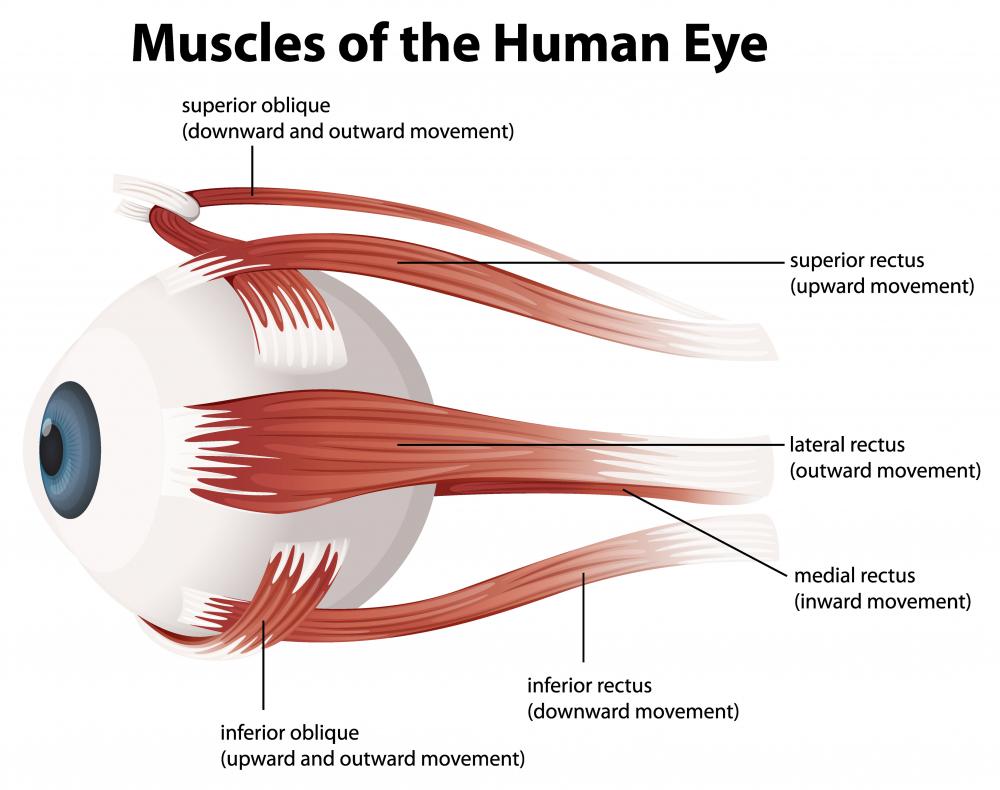At WiseGEEK, we're committed to delivering accurate, trustworthy information. Our expert-authored content is rigorously fact-checked and sourced from credible authorities. Discover how we uphold the highest standards in providing you with reliable knowledge.
What Is the Inferior Rectus Muscle?
There are six extraocular muscles that together move the pupil up, down, side to side and in combinations of these gazes. As its name denotes, the inferior rectus muscle attaches to the sclera — the white "ball" of the eyeball — at the bottom of the structure and primarily works to move the gaze downward in a process known as depression. The other extraocular muscles are the superior rectus, medial rectus, lateral rectus, superior oblique and the inferior oblique. All but one of these muscles form a conical shape in each eye orbit, with the mouth of the cone where the muscles connect to the eyeball and the sharp point of the cone where the muscles converge together in a ring-shaped tendon. The optic nerve, cranial nerve II, runs through this ring-shaped tendon through the cone to the pupil.
The four inferior and superior extraocular muscles each have three functions of varying responsibility. The primary function of the inferior rectus muscle is the downward movement or depression of the pupil. A secondary function of the inferior rectus muscle is the rotation of the top of the eyeball away from the nose in a process known as extorsion. Finally, the tertiary function of this muscle is to move the pupil inward, or medially, in adduction.

Some eye motions are the result of just one extraocular muscle contraction while others require two muscles working in conjunction. The muscle primarily responsible for the pupil's movement is referred to as the agonist. Other extraocular muscles that assist in the motion are known as synergists. Those extraocular muscles that move the pupil in an opposite direction are antagonists. Thus, the inferior rectus muscle is the agonist for a pupil's downward motion; the synergist for extorsion or adduction; and the antagonist for the superior rectus muscle's movement of the eye upward during elevation.

These descriptions refer to the movement of one eye only, which is called a duction. For a single pupil's gaze downward, this downward depression motion is also known as infraduction. When two eyes work together, however, the eye movement is known as a version. To look down with both eyes, performing either an infraversion or deorsumversion, both the right and left inferior rectus muscles — or recti — must contract to force the motion. In addition, the right and left superior oblique recti work as synergists to the inferior rectus muscle to move each eye in the same direction.
AS FEATURED ON:
AS FEATURED ON:













Discussion Comments
@SarahSon - Not only are the eyes complex, but they are also very quick to heal if something happens.
I worked at an eye doctor's office and would see many people who scratched their eyes by wearing their contacts too long.
Their eyes would heal quickly if they took out their lenses and gave their eyes a rest. The eye muscles are similar to other muscles in your body regarding overuse as well.
Many times when you exercise too hard, you don't realize it at the time. The next day is when you wake up and realize how sore your muscles are.
The eye muscles are the same way. They can take some abuse and you don't even realize it until it is too late. Thankfully, they often heal very quickly, but I never want to take advantage of this.
I want my eyes to work well for me my whole lifetime.
Every time I have my regular appointment with my eye doctor, he has me look up, down and to the side with both of my eyes.
I had no idea there were so many eye muscles involved in this process. I think the eye is one of the most interesting and complex parts of our body.
It seems almost strange to think of your eyes as having muscles, but there are a lot of them there.
I knew a girl who was cross-eyed. They gave her exercises to work on to help strengthen her eye muscles. Just like every other part of your body, your eye muscles can be strengthened if you know the right exercises to do.
Post your comments